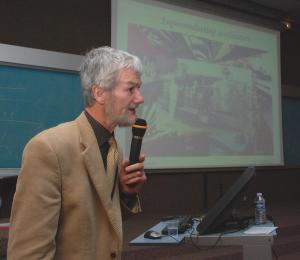The century of critical temperature
2 Dec 2011
-
Sabina Griffith
Martin Wilson during his "Inside ITER" talk this week, which highlighted the achievements of a century of superconconductivity.
Some years ago, Pierre Bauer would certainly not have dreamed that one day he would stand to introduce the man who once initiated his PhD thesis.
But that is exactly the position he found himself in this week in front of assembled ITER staff as he announced the lecturer for the Inside ITER seminar "100 Years of Superconductivity: 50 Years of Superconducting Magnets."
Martin Wilson, a former member of the Rutherford Group and a guru of superconductivity, is now officially retired, but he is still "a tornado of activity, thoughts and ideas," as Pierre respectfully said. Instead of rocking in an armchair, Martin Wilson continues to tour the world to consult and educate in the field of applied superconductivity, a domain that never failed to surprise him.
This year Martin Wilson joined the long line of pilgrims to Leiden, a town in the Netherlands, where one hundred years ago the Dutch physicist Heike Kammerlingh Onnes was successful in liquefying helium - the breakthrough that led to the discovery of superconductivity.
From Leiden, Wilson had brought back plenty of images and anecdotes which he used to jovially illustrate the milestone achievements within one century of superconductivity: from the "blue collar boys" performing the first simple experiments in Onnes' backyard ... to the MIT conference in 1961 where the first applications of superconductors were presented ... and the meeting in New York 26 years later which turned into the "Woodstock of Physics."
"The major breakthroughs seem to happen in quarter-century steps," Martin Wilson concluded his talk. "Down here is ITER," he said, pointing to the bottom of a list of milestones. "And with this, I hand over to you guys."
See related video "Mercury practically zero."


